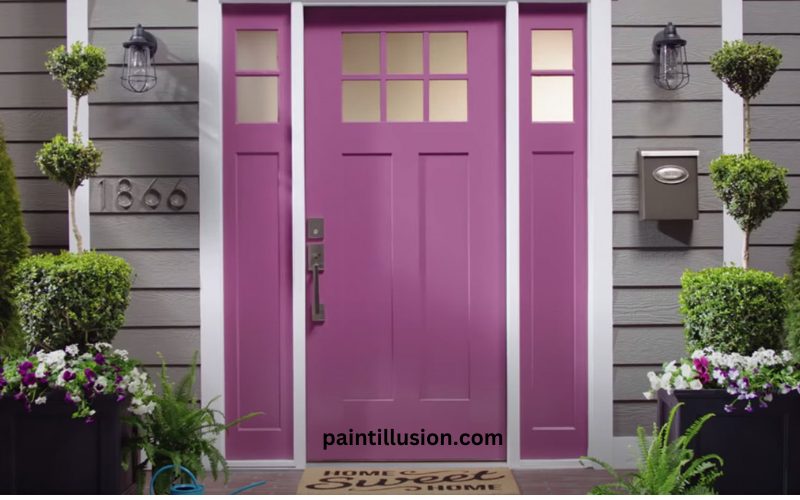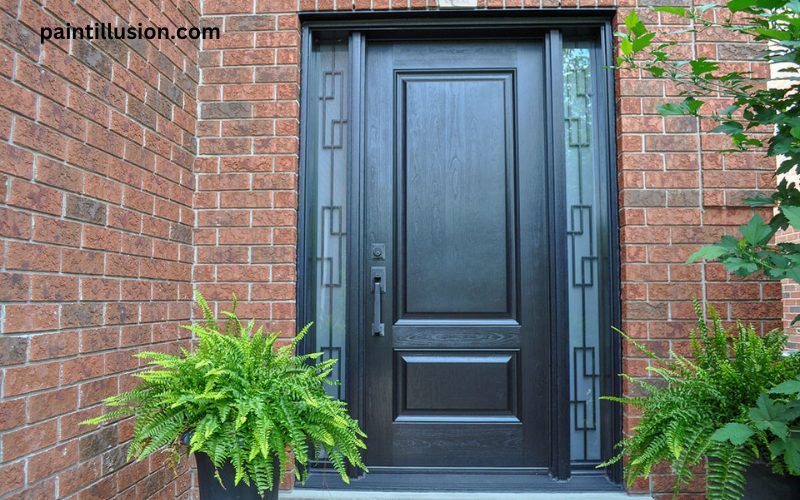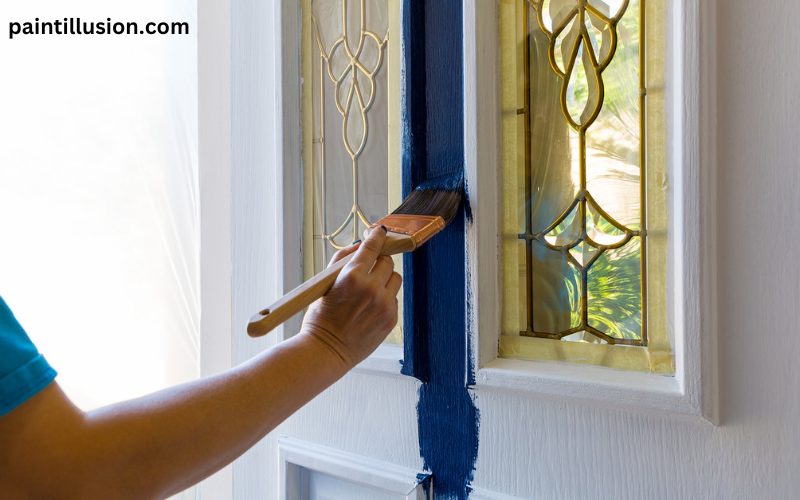Paint a Fiberglass Door is a popular choice for many homeowners due to its durability and low maintenance. However, over time, the color of the door may fade or become outdated. Painting a fiberglass door is a cost-effective way to refresh its appearance and give it a new lease on life. In this guide, we will take you through the step-by-step process of painting a fiberglass door, from preparation to finishing touches. Whether you are a seasoned DIY enthusiast or a beginner, this article will provide you with all the information you need to successfully paint your fiberglass door.
Preparing the Fiberglass Door for Painting
Before you start painting, it is essential to properly prepare the fiberglass door to ensure a smooth and long-lasting finish. Here are the steps to follow:
- Clean the Door: Begin by cleaning the door thoroughly to remove any dirt, dust, or grease. Use a mild detergent or a mixture of water and vinegar to gently scrub the surface. Rinse the door with clean water and allow it to dry completely.
- Sand the Surface: Next, lightly sand the surface of the door with fine-grit sandpaper. This will help remove any rough spots or imperfections and create a better surface for the paint to adhere to. Be sure to sand in the direction of the grain to avoid damaging the fiberglass.
- Repair Any Damage: Inspect the door for any cracks, dents, or holes. Use a fiberglass repair kit to fill in any damaged areas and smooth them out. Allow the repair compound to dry according to the manufacturer’s instructions before moving on to the next step.
- Mask Off Areas: To protect any hardware or glass inserts on the door, use painter’s tape to carefully mask off these areas. This will prevent accidental paint splatters and make the painting process more precise.

Choosing the Right Paint for a Fiberglass Door
Selecting the right paint is crucial for achieving a professional-looking finish and ensuring the longevity of your painted fiberglass door. Consider the following factors when choosing the paint:
- Type of Paint: Opt for a paint specifically designed for use on fiberglass surfaces. Look for a high-quality exterior-grade paint that is resistant to fading, cracking, and peeling. Acrylic latex paint is a popular choice for fiberglass doors due to its durability and ease of application.
- Color Selection: Choose a color that complements the overall aesthetic of your home. Consider the architectural style, existing color scheme, and personal preference. It is recommended to test the color on a small, inconspicuous area of the door to ensure you are happy with the result before painting the entire door.
- Finish: Decide on the desired finish for your fiberglass door. Satin or semi-gloss finishes are commonly used for exterior doors as they provide a good balance between durability and aesthetics. A gloss finish can create a more vibrant and polished appearance, but it may require more maintenance.
- Quantity: Calculate the amount of paint you will need based on the dimensions of your fiberglass door. Most paint manufacturers provide coverage information on their product labels, which will help you determine the quantity required. It is always better to have a little extra paint than to run out in the middle of the project.
Steps to Paint a Fiberglass Door
Now that you have prepared the door and chosen the right paint, it’s time to start painting. Follow these steps for a professional-looking finish:
- Prime the Door: Apply a coat of primer specifically formulated for use on fiberglass surfaces. Primer helps the paint adhere better and provides an even base for the topcoat. Use a paintbrush or a roller to apply the primer in long, smooth strokes, following the grain of the fiberglass.
- Paint the Edges: Start by painting the edges of the door using a brush. Take your time and apply the paint evenly, making sure to cover all the edges. This will create a clean and finished look once the door is installed.
- Paint the Panels: Next, paint the panels of the door. If the door has recessed panels, use a brush to apply the paint in the corners and edges. Then, use a roller to fill in the remaining area of the panels. Work in small sections, blending the paint strokes as you go to create a seamless finish.
- Paint the Stiles and Rails: Once the panels are painted, move on to the stiles and rails of the door. These are the vertical and horizontal parts that frame the panels. Use a brush or a roller to apply the paint, following the direction of the grain. Take care to avoid drips or uneven coverage.
- Allow the Paint to Dry: After applying the first coat of paint, allow it to dry according to the manufacturer’s instructions. This usually takes a few hours. Once the first coat is dry, apply a second coat for better coverage and durability. Again, let the paint dry completely before handling or installing the door.
Tips for Achieving a Smooth and Even Finish
To ensure a smooth and even finish on your painted fiberglass door, consider the following tips:
- Work in a Well-Ventilated Area: Choose a well-ventilated area for painting to allow for proper air circulation and faster drying. If you are painting indoors, open windows and use fans to improve ventilation.
- Use High-Quality Brushes and Rollers: Invest in high-quality brushes and rollers to achieve a professional finish. A good brush will hold more paint and distribute it evenly, while a high-quality roller will leave fewer streaks and provide better coverage.
- Apply Thin Coats: It is better to apply multiple thin coats of paint rather than one thick coat. Thin coats dry faster, minimize the risk of drips or runs, and result in a smoother finish. Allow each coat to dry completely before applying the next one.
- Avoid Overbrushing: Overbrushing can lead to brush marks and an uneven finish. To avoid this, work quickly and smoothly, following the direction of the grain. Use long, even strokes and refrain from going over the same area repeatedly.
- Clean Up Properly: After completing the painting process, clean your brushes, rollers, and other painting tools thoroughly according to the manufacturer’s instructions. Proper cleaning will ensure their longevity and allow for future use.

Caring for a Painted Fiberglass Door
To maintain the beauty and longevity of your painted fiberglass door, follow these care tips:
- Regular Cleaning: Clean the door regularly using a mild detergent and water. Avoid using abrasive cleaners or harsh chemicals as they can damage the paint finish. Gently wipe the door with a soft cloth or sponge, rinsing with clean water afterward.
- Avoid Scratching: Be cautious when handling objects near the door to avoid scratching or damaging the painted surface. Use caution while moving furniture or other items through the doorway.
- Protect from Extreme Temperatures: Fiberglass can expand and contract with temperature changes. To prevent any damage to the paint or the door itself, avoid exposing it to extreme heat or cold. Consider installing a storm door or providing shade to protect the door from direct sunlight.
- Inspect Regularly: Periodically inspect the door for any signs of damage or wear. If you notice any chips, cracks, or peeling paint, address the issue promptly to prevent further damage. Touch up any minor imperfections using the same paint color and finish.
- Repaint as Needed: Over time, the painted surface may fade or become worn. If the door starts to look dull or the paint becomes damaged, consider repainting it. Follow the same preparation and painting process outlined in this article for a fresh and revitalized look.
FAQs about Painting Fiberglass Doors
Q: Can I paint a fiberglass door that is already painted?
A: Yes, you can paint a fiberglass door that has already been painted. However, it is important to properly prepare the surface by cleaning and sanding it before applying a new coat of paint. Follow the steps outlined in this article for the best results.
Q: How long does the paint on a fiberglass door last?
A: The lifespan of the paint on a fiberglass door will depend on various factors such as the quality of the paint, exposure to the elements, and proper maintenance. With proper care, a well-painted fiberglass door can last for many years before needing a touch-up or repaint.
Q: Can I use spray paint on a fiberglass door?
A: While spray paint can be used on a fiberglass door, it requires proper technique and skill to achieve a smooth and even finish. It is recommended to use a brush or roller for better control and coverage.
Common Mistakes to Avoid When Painting a Fiberglass Door
To ensure a successful painting project, avoid the following common mistakes:
- Skipping the Preparation: Properly preparing the fiberglass door is crucial for a lasting finish. Skipping steps such as cleaning, sanding, and repairing any damage can result in poor adhesion and a subpar paint job.
- Using the Wrong Paint: Using interior paint, oil-based paint, or low-quality paint on a fiberglass door will lead to premature peeling, cracking, and fading. Always choose a high-quality exterior-grade paint specifically designed for fiberglass surfaces.
- Not Allowing Sufficient Drying Time: Rushing the drying process can lead to smudges, smears, or damage to the painted surface. Follow the manufacturer’s instructions for drying times between coats and before handling or installing the door.
- Applying Too Thick of a Coat: Applying a thick coat of paint may seem like a time-saver, but it can result in drips, runs, and an uneven finish. Stick to thin coats, allowing each coat to dry completely before adding another.
- Neglecting Regular Maintenance: Once the door is painted, it is important to regularly clean and inspect it for any signs of damage or wear. Addressing minor issues promptly will prevent them from becoming major problems.
Hiring a Professional vs. DIY Painting a Fiberglass Door
Deciding whether to hire a professional or tackle the painting project yourself depends on your skill level, available time, and budget. Here are some factors to consider:
DIY Painting:
- Cost-effective: Painting a fiberglass door yourself can save you money on labor costs.
- Flexibility: You can choose your own paint color, finish, and schedule.
- Learning opportunity: DIY painting allows you to gain new skills and knowledge.
- Time commitment: Painting a fiberglass door requires time and patience, especially during the preparation and drying stages.
Hiring a Professional:
- Expertise: Professionals have the experience and skill to achieve a flawless finish.
- Time-saving: Hiring a professional allows you to focus on other tasks while they take care of the painting.
- Professional equipment: Professionals have access to specialized tools and equipment for a superior result.
- Warranty: Some professional painters offer warranties or guarantees on their work.
Consider your own abilities, resources, and preferences before making a decision. If you are confident in your DIY skills and have the time to dedicate to the project, painting a fiberglass door yourself can be a rewarding and cost-effective option. However, if you prefer to leave it to the experts or lack the time and expertise, hiring a professional painter ensures a high-quality and hassle-free result.
Conclusion
Painting a fiberglass door is an excellent way to refresh the look of your home’s exterior and protect the door from the elements. By following the step-by-step process outlined in this article and avoiding common mistakes, you can achieve a professional-looking finish that will last for years to come. Remember to properly prepare the door, choose the right paint, and follow the recommended techniques for a smooth and even result. With proper care and maintenance, your painted fiberglass door will continue to enhance the beauty and curb appeal of your home. So roll up your sleeves, grab your paintbrush, and transform your fiberglass door into a stunning focal point of your home’s exterior.


Thanks for every other informative blog. Where else may just I am getting that kind of information written in such an ideal means? I’ve a undertaking that I’m just now operating on, and I’ve been on the glance out for such information.